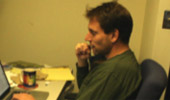The Physics & Astronomy Colloquium Series presents Ryan Chornock of Harvard-Smithsonian Center for Astrophysics on “Transient Astronomy and the Violent Deaths of Stars” at a special time on Wednesday, Jan. 29, at 4:10 p.m. in Walter 245.
Abstract: The advent of systematic time-domain astronomical surveys is opening a new window of discovery to the universe. I will describe a few exciting recent results using astronomical transients discovered with the current Pan-STARRS1 survey. We have been finding some of the most luminous and distant supernovae in the universe and using them as probes of both the extreme deaths of massive stars and of their star-forming host galaxies. We have also identified the first two examples of optical transients with complete light curves associated with the tidal disruptions of stars and subsequent accretion of the debris by supermassive black holes. I will describe the relationship between our observations and the theoretical predictions in this emerging field. I will also discuss the implications of our work for future surveys, such as the Large Synoptic Survey Telescope (LSST), which will commence operations in a decade.
Upcoming Spring 2014 Events
Colloquia are held in the Walter Hall, Room 245, on Fridays at 4:10 p.m. unless otherwise noted.
Henry Clark of Texas A&M University on “Radioactive Ion Beam Physics at the Cyclotron Institute” on Friday, Jan. 31, at 4:10 p.m. in Walter 245.
Jens Dilling of the University of British Columbia on “Understanding the universe, one rare isotope at a time” on Friday, Feb. 7, at 4:10 p.m. in Walter 245.
Michelle Espy of Los Alamos Scientific Lab on “Applications of SQUIDs: from brains to bombs” on Friday, Feb. 21, at 4:10 p.m. in Walter 245.
John Wikswo of Vanderbilt University on “A Physicist’s Perspective on the Complexity of Biology” on Friday, Feb. 28, at 4:10 p.m. in Walter 245.
TBA on Friday, March 14, at 4:10 p.m. in Walter 245.
Serge Nakhmanson of the University of Connecticut on “Computational Design of Multifunctional Complex-oxide Materials Across Length Scales” on Friday, March 21, at 4:10 p.m. in Walter 245.
Maxim Pospelov of the University of Waterlooon “Constraining the Dark Sector with BBN and CMB physics” on Friday, March 28, at 4:10 p.m. in Walter 245.
Jennifer Dionne of Stanford University on “Visualizing chemical reactions and light-matter interactions with nanometer-scale resolution” on Friday, April 4, at 4:10 p.m. in Walter 245.
Robert Austin of Princeton University on “Nonlinear Dynamics” on Friday, April 11, at 4:10 p.m. in Walter 245.
Nick Wu of the West Virginia University on “Plasmon-Enhanced Solar Energy Harvesting” on Friday, April 18, at 4:10 p.m. in Walter 245.
Departmental Awards Gathering on Friday, April 25, at 4:10 p.m. in Walter 245.

















Comments